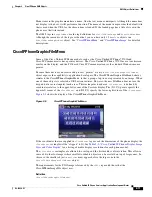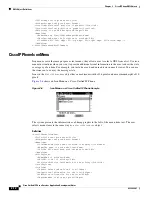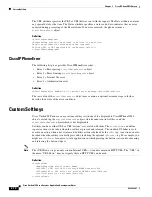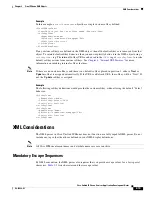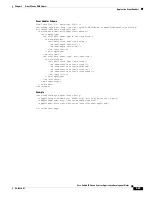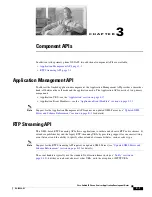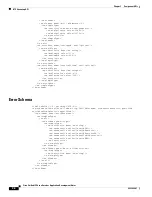
2-19
Cisco Unified IP Phone Services Application Development Notes
OL-18696-01
Chapter 2 CiscoIPPhone XML Objects
XML Considerations
Example
In this example, a
CiscoIPPhoneText
object has a single custom softkey defined:
<CiscoIPPhoneText>
<Text>This object has one softkey named "Custom"</Text>
<SoftKeyItem>
<Name>Custom</Name>
<URL>http://someserver/somepage</URL>
<Position>4</Position>
</SoftKeyItem>
</CiscoIPPhoneText>
If any custom softkeys are defined in the XML object, then all default softkeys are removed from that
object. To retain default softkey behavior, then you must explicitly define it in the XML object using a
<SoftKeyItem>
tag. The internal Softkey URIs can be used in the
<URL>
tag of
<SoftKeyItem>
to invoke
default softkey actions from custom softkeys. See
Chapter 4, “Internal URI Features”
for more
information on invoking internal softkey features.
Note
If there are no custom softkeys and there is no default softkey placed in position 1, either a
Next
or
Update
softkey is assigned automatically. If the URL is a Refresh URL, the softkey will be “Next.” If
not, the
Update
softkey is assigned.
Example
The following softkey definitions would provide the custom softkey, without losing the default “Select”
behavior:
<SoftKeyItem>
<Name>Select</Name>
<URL>SoftKey:Select</URL>
<Position>1</Position>
</SoftKeyItem>
<SoftKeyItem>
<Name>Custom</Name>
<URL>http://someserver/somepage</URL>
<Position>4</Position>
</SoftKeyItem>
XML Considerations
The XML parser in Cisco Unified IP Phones does not function as a fully capable XML parser. Do not
include any tags other than those defined in your XML display definitions.
Note
All CiscoIPPhone element names and attribute names are case sensitive.
Mandatory Escape Sequences
By XML convention, the XML parser also requires that you provide escape values for a few special
characters.
Table 2-5
lists characters and their escape values.







